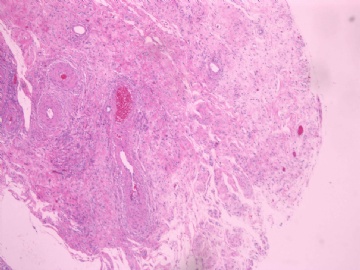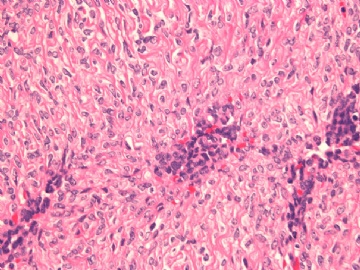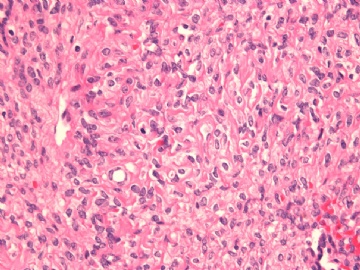| 图片: | |
|---|---|
| 名称: | |
| 描述: | |
- 子宫透明细胞肿瘤2?
-
本帖最后由 于 2010-03-26 23:00:00 编辑
| 以下是引用海上明月在2010-3-23 17:03:00的发言: 需要注意有无性索分化的区域 Ann Diagn Pathol. 2010 Apr;14(2):129-32. Epub 2009 Aug 14. A new morphological variant of uterine PEComas with sex-cord-like pattern and WT1 expression: more doubts about the existence of uterine PEComas.Carvalho FM, Carvalho JP, Maluf FC, Bacchi CE. Department of Pathology, Faculdade de Medicina da Universidade de São Paulo, São Paulo (SP), Brazil. filomena@usp.br PEComas are rare neoplasms that are sometimes associated with the tuberous sclerosis complex. They typically contain perivascular epithelioid cells that coexpress muscle and melanocytic markers. However, apart from these classical features, considerable clinical, pathologic, and immunohistochemical variation has been reported. WT1, the Wilms tumor gene product, can be expressed in various tumors from different anatomical sites, including sex-cord and other ovarian tumors with a sertoliform pattern. Neither a sex-cord-like pattern nor WT1 expression has been described in PEComas. Here, we describe a case of uterine PEComa with a pattern of infiltration into the myometrium that is similar to stromal sarcomas, characterized by tongues and endovascular growing. The architecture and cellular morphology were similar to sex-cord tumors, and the PEComa was diffusely and strongly positive for WT1. We reviewed, from our files, an additional 9 cases of PEComa from different sites, and found WT1 expression in one more soft tissue tumor. We discuss the relationship between PEComas and other uterine sarcomas. |
PEComas 是一类与复合性结节性硬化病相关的少见肿瘤,用肌细胞和黑色素细胞标记物可标记血管周上皮细胞。WT1能表达在不同的肿瘤中,包括性索和其他具有具有血管周上皮样细胞分化的卵巢肿瘤,但WT1在PEComas的类性索型不表达,本文研究1例与间质肉瘤相似的侵袭子宫肌层的子宫PEComas,结构和细胞形态学与性索肿瘤相似,PEComas弥漫性强表达WT1,笔者还回顾了9例PEComas,发现WT1不只表达在软组织肿瘤,同时讨论PEComas和其他子宫肉瘤的相关性
-
本帖最后由 于 2010-03-27 01:51:00 编辑
Ann Diagn Pathol. 2010 Apr;14(2):129-32. Epub 2009 Aug 14.
PEComa伴有性索样特征和WT1表达的形态学新变异型:对子宫存在本变型的深入质询
PEComas是一种少见的肿瘤,有时与结节性硬化并发。该肿瘤典型特征是含有血管周上皮样细胞,复合表达肌性与黑素细胞性标志物。然而,除了这些典型的特征之外,有一些临床、病理和免疫组化变异的报道。Wilms瘤基因产物WT1,可表达在不同部位的不同类型的肿瘤中,包括伴有支持细胞特征的卵巢性索肿瘤及其它肿瘤。以前报道的PEComa既不具有性索样特征,也不表达WT1。本文报道一例PEComa的特征:类似子宫间质肉瘤那样浸润肌层,并呈舌状向血管内生长。组织结构和细胞形态类似于性索肿瘤。免疫组化显示WT1呈弥漫性强阳性表达。作者复习9例发生在不同部位PEComa存档病例时,发现WT1不只在一种软组织肿瘤中有表达,本文讨论了 PEComa和其他子宫肉瘤之间的关系。
-----海上明月 2010-03-26重新排版

- 王军臣
-
本帖最后由 于 2010-03-25 12:30:00 编辑
Adv Anat Pathol. 2008 Mar;15(2):63-75.
41例子宫PEComa基于预后的临床病理分析
PEComa是目前尚未阐明的一种肿瘤,其特征由不同数量的梭形细胞和上皮样细胞构
成,胞浆透明至嗜酸性,免疫组化显示黑色素细胞标志物,最常见为HMB45。迄今文
献报道最多见的发生部位是子宫和腹膜后。本文复习了以前报道的41例子宫
PEComa,其中31 例发生在子宫体部。根据随访资料(或临床恶性生物学行为),将
全部病例分成两组:(1)恶性组(为I组,n=13):本组为病故患者和/或临床证明恶
性(有局部和/或 子宫外远处转移);(2) 非恶性组(II组,n=18):无上述恶性
表现。I组与II组比较,随访的时间(分别为25 mo与 24.3 mo, P=0.9)和患者年龄均
(分别为45.61 y 与 43.46,P=0.7)无统计学差异。I组中,有5名患者发生远处(腹
外)转移,肿瘤体积比II组大(平均大小分别为9.6 cm与4.67 cm, P=0.04);尽管
肿瘤大小对于区分PEComa是否恶性有75%及其以上是可信的,但肿瘤大小不是区分两
组的唯一标准。凝固性坏死才具有高度相关性,恶性组有坏死的病例达到82% ,而
非恶性组仅为 11.8% (P=0.0002)。非恶性组88%的病例中,核分裂计数只有1/10
HPF或以下,相比之下恶性组却不是这样,仅有40% 病例核分裂计数在1/10 HPF
(P=0.01)。但是,没有见到核分裂并不排除恶性,例如恶性组中有1个患者无核分
裂,但却发生了远处转移。所有病例中,免疫组化检测CD10、desmin、vimentin、
SMA和caldesmon的阳性率分别为:25%、49%、56%、73% 和100% 。综上所述,
PEComa 是一类组织起源和恶性潜能未定的肿瘤,形态与免疫表型有些与平滑肌肿瘤
相互重叠,一旦核分裂计数>1/10 HPF和/或凝固性坏死,提示为侵袭性行为。
海上明月2010-03-25 12:26 重新排版

- 王军臣
| 以下是引用海上明月在2010-3-23 17:00:00的发言: 需要鉴别恶性PEComa Diagn Pathol. 2007 Dec 3;2:45. Malignant perivascular epithelioid cell tumor (PEComa) of the uterus with late renal and pulmonary metastases: a case report with review of the literature。子宫恶性PEComa伴后期肾脏和肺转移:1例报道及文献复习 Department of Pathology, University of Pittsburgh Medical Center, Pittsburgh, PA, USA. armahh2@upmc.edu. ABSTRACT: BACKGROUND: Perivascular epithelioid cell tumor (PEComa), other than angiomyolipoma (AML), clear cell sugar tumor (CCST), and lymphangioleiomyomatosis (LAM), is a very rare mesenchymal tumor with an unpredictable natural history. The uterus is the most prevalent reported site of involvement of PEComa-not otherwise specified (PEComa-NOS).To the best of our knowledge, about 100 PEComa-NOS have been reported in the English Language wymedical literature, of which 38 were uterine PEComa-NOS. These reported cases of uterine PEComa-NOS have usually shown clinically benign behavior, but 13 tumors, three of them associated with tuberous sclerosis complex (TSC), exhibited local aggressive behavior and four of them showed distant metastases.CASE PRESENTATION: We report the case of a 59-year-old woman, who presented with renal and pulmonary lesions seven years after the initial diagnosis of uterine leiomyosarcoma. Left nephrectomy and right middle lobe wedge resection were performed. Histological and immunohistochemical analysis of the renal and pulmonary lesions, in addition to retrospective re-evaluation of the previous uterine tumor, led to the final diagnosis of malignant uterine PEComa with late renal and pulmonary metastases. All three lesions had the typical histological appearance of PEComa-NOS showing a biphasic growth pattern with continuous transition between spindle cells and epithelioid cells, often arranged around vascular spaces. Immunohistochemically, the tumor cells of both phenotypes in all three lesions stained for melanocytic (HMB-45 and Melan-A/MART-1) and myoid (desmin, smooth muscle actin, and muscle-specific actin/all muscle actin/HHF-35) markers. CONCLUSION: The findings indicate that despite the small number of reported cases, PEComas-NOS should be considered tumors of uncertain malignant potential, and metastases to other organs might become evident even several years after the primary diagnosis. |

- 广州金域病理
| 以下是引用海上明月在2010-3-23 16:54:00的发言:
Int Semin Surg Oncol. 2008 Mar 6;5:7. Uterine PEComa: appraisal of a controversial and increasingly reported mesenchymal neoplasm.子宫PEComa:一个有争议的和逐渐报道的间叶肿瘤的评价 Department of Pathology, Wilford Hall Medical Center, Lackland Air Force Base, San Antonio, TX 78236, USA. oluwolefadare@yahoo.com.
ABSTRACT: In recent years, a group of tumors that have been designated "perivascular epithelioid cell tumors" (PEComa) have been reported with increasing frequency from a wide variety of anatomic locations. The uterus and retroperitoneum appear to be the most frequent sites of origin for these lesions. PEComas belong to an identically named family of tumors comprised of conventional angiomyolipomas, clear cell sugar tumors, lymphangiomyomatosis and clear cell myomelanocytic tumor of the falciform ligament/ligament teres, and are also known as PEComa-NOS. This article is a primer for clinicians on the most salient clinicopathologic features of uterine PEComas, as most of the debate and discussion have taken place in the pathologic literature. The author appraises in detail the current state of knowledge on PEComas of the uterus based on a review of published data on the 44 previously reported cases, and comments on areas of controversy. The latter are centered predominantly on the significant morphologic and immunophenotypic overlap that exists between uterine PEComa and some smooth muscle tumors of the uterus. The clinicopathologic features of cases reported as epithelioid smooth muscle tumors and cases reported as uterine PEComas are compared and contrasted, and a practical approach to their reporting is proposed. |
近年来,PEComa的报道逐渐增多,发病部位也较宽。子宫和腹膜后似乎是最常见的发病部位。PEComas属于血管平滑肌脂肪瘤同家族成员之一,透明细胞糖瘤,淋巴管肌瘤病和镰状韧带透明细胞肌黑色素细胞瘤/韧带,也是被称为PEComa-NOS。这篇文章是对子宫PEComas最突出的临床病理特征作了大部分讨论,已收在病理文献中。作者在先前报道的44例的基础上详细评价了子宫PEComas现状,并进行部分讨论。后者主要集中讨论了子宫PEComa和子宫平滑肌肿瘤的形态学和免疫组化上有些交叉重叠。对比和比较上皮样平滑肌瘤和子宫的PEComa的临床病理特征,提出切实可行的报告。

- 广州金域病理























